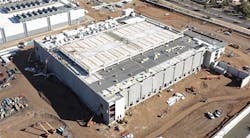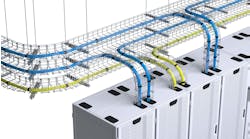CHANDLER, Ariz. – To understand the cloud computing boom’s impact on Phoenix, just drive past a 57-acre property in the Continuum Business Park that houses a data center campus for CyrusOne.
In 2011, the site featured herds of sheep grazing on fields of alfalfa. CyrusOne, which at the time was a unit of Cincinnati Bell, had just announced plans to build 1 million square feet of space in Chandler’s emerging data center district.
In November 2012 we toured the initial data center, a month before it accepted its first customer. Construction crews raced to put the finishing touches on the 200,000 square foot first building, which was surrounded by acres of empty land, with alfalfa fields to the west and large piles of dirt to the east, along with pads for future buildings and curbs forming the outlines of roads to come.
Last month we returned to Chandler and found a changed landscape. The open land and alfalfa crops have given way to building after building, all filled with servers powering the world’s largest cloud computing platforms.
The CyrusOne campus now houses seven massive data centers, with space for three more. The initial plan for 1 million square feet of data center space, which seemed outlandish at the time, has been doubled to 2 million square feet. It will soon host more than 100 megawatts of commissioned data center space.
The Chandler development tells the story of CyrusOne, which has been a leader in the rapid growth of the data center industry, advancing techniques for building at speed and scale. The company is on the forefront of a trend in which the world’s largest hyperscale Internet companies have begun leasing cloud capacity from data center developers, rather than building their own server farms.
Since it broke ground on that first Phoenix facility, CyrusOne has grown into an independent, publicly-held data center REIT (real estate investment trust) that has deployed more than 700 megawatts and 3.8 million square feet of capacity – including 103 megawatts in 2018 alone.
Accelerating Hyperscale Delivery
CyrusOne’s success has helped put the Phoenix region on the map as a hyperscale destination. The Chandler campus also played a critical role in establishing CyrusOne’s ability to deliver space quickly, which has helped it win deals from cloud builders who want a lot of space, and want it fast.
In 2014, CyrusOne transformed a powered shell on the Chandler campus into a finished 9-megawatt data center in just 107 days, a speed which was unusual at the time. It was the first demonstration of the “secret sauce” for CyrusOne: a relentless focus on using pre-fabricated components and lean construction strategies to accelerate data center construction.
“CyrusOne has had a vision that’s very consistent – providing exceptional velocity and a quality colocation experience,” said John Gould, the Chief Commercial Officer for CyrusOne. “We have the ability to go build a facility from dirt to completion in six months. We have intentionally tried to simplify our business. We have a standard product that’s entirely repeatable. It’s supply chain 101.”
The company’s focus on rapid deployment has helped it reach the very top levels of the data center business. When applied at scale, over time, those techniques allow CyrusOne to create massive data center campuses, as seen in these aerial photos of the Chandler site:
An aerial view of the Chandler campus in 2012 shows the single building, with site work underway on some neighboring parcels, while others are still covered with crops of alfalfa (at left and far right). (Photo: CyrusOne)
A little more than six years later, that initial building (Building 3) is surrounded by five more data centers, with a sixth under construction. The campus has land for another three buildings. Click image to see a larger view. (Image: CyrusOne)
CyrusOne says it can deploy new data center capacity at a cost of $6.3 million per megawatt, making it one of the most efficient players in data center development. This combination of speed and affordability has allowed the company to compete aggressively with rivals such as Digital Realty, CoreSite, RagingWire and Iron Mountain for large “super-wholesale” leasing deals with hyperscale computing companies.
“We made a splash very quickly and had a lot of success with key accounts,” said Gould. “Anyone can build a good data center. Can you build it at the right cost and the right time? We’ve prosecuted that advantage.”
A History of Growth
CyrusOne was founded in 2000 by Houston entrepreneur David Ferdman, and quickly found its niche specializing in high-density colocation services for energy companies in Houston and Dallas. The company, which was named for a Persian ruler featured in the Old Testament, expanded across Texas after it was acquired in 2007 by private equity firm ABRY Partners. In 2010, Cincinnati Bell paid $525 million to buy CyrusOne, which was then spun off in an IPO in January 2013, just as the company delivered the first building in Chandler.
The growth in Chandler reflects CyrusOne’s focus on both speed and scale. The campus was the initial canvas for its “Massively Modular” data center design, which leverages the company’s supply chain to support a repeatable approach that slashes cost and time to market. Key elements include:
- CyrusOne works with vendors on bulk purchases of any equipment that requires a long lead time, housing dozens of generators or UPS units in storage depots for rapid deployment.
- Designing buildings to reduce the amount of trenching needed for power and fiber infrastructure, which further shortens timelines.
- The use of pre-fabricated concrete panels that can be rapidly deployed to create the “tilt-up” building shell. Up to 60 panels a day can be installed using this technique.
- In the data hall, CyrusOne uses a structural ceiling grid to support cable trays and power busways. The room is framed with a polycarbonate panel that can be deployed without the construction processes required for “drywall” gypsum board partitions.
- A key accelerant is the design and installation of power rooms, which include emergency diesel generators and UPS units. The electrical rooms are pre-fabricated off-site and containerized, and then installed using trucks and cranes. The data center has openings along the side of the building, which are pre-plumbed to easily connect the room to the building’s electrical infrastructure.
CyrusOne followed the 107-day rollout in Phoenix with a dirt-to-data delivery of a 20-megawatt data center in six months for a hyperscale client in Sterling, Virginia. Other providers had used elements of this approach – especially pre-fab power rooms. But after CyrusOne won a series of large super-wholesale deals, its rivals quickly began moving to further integrate lean construction and pre-fab components to accelerate their own deployments.
Looking to Europe for the Next Phase of Growth
For its next act, CyrusOne is going global with a strategy that includes both buying and building. In 2017 it made a strategic investment in GDS, the leading developer of hyperscale data centers in China. Last year it formed a partnership with ODATA, which builds mission-critical facilities in Brazil and Colombia.
An important strategic deal has been CyrusOne’s acquisition of European specialist Zenium Data Centers, which operates campuses in the London and Frankfurt markets. It has also been preparing to build in key European markets, acquiring two sites in Amsterdam that will support more than 340 megawatts of capacity.
The CyrusOne San Antonio II data center provides an example of a data center with an office attached. (Photo: Rich Miller)
Gould confirms that CyrusOne is keenly focused on growth in Europe, where the “FLAP” (Frankfurt-London-Amsterdam-Paris) markets have become hubs for both hyperscale and enterprise data center deployments.
“In many Western European countries, you’re seeing cloud adoption taking off,” said Gould. “I think there is a consistent theme that Europe has been three to five years behind the rate of adoption in the US. The early foothold offers a strategic advantage.”
CyrusOne’s investments in its international partners have reaped broad benefits. The relationship with GDS has helped CyrusOne sign 20 megawatts of leasing with Chinese hyperscale companies. In addition, the value of CyrusOne’s $100 million equity investment in GDS has nearly tripled to $290 million. Earlier this month, CyrusOne sold some of that stake to raise $200 million to fund new data center construction, averting the need to use debt or issue new CyrusOne stock to fund growth.
Major US Markets Will Remain Hot
Although it has big global ambitions, CyrusOne will continue to add capacity to keep pace with demand in the United States.
“We’re going to see plenty of growth in the U.S.,” said Gould. “I don’t see a slowdown. There could be a short-term pause for a quarter or two, but the (cloud providers) are all projecting big growth ahead. They can’t be caught flat-footed.
“The hot markets are only becoming hotter, and I think they’ll stay hot for some time,” he added.
Download the DCF Special Report covering the Phoenix Data Center Market.
That includes Phoenix, which is home to more than 1.6 million square feet of commissioned data center space, according to market research from DCF and datacenterHawk, and recently became the fifth-largest market for data center capacity in the U.S., trailing Northern Virginia, Silicon Valley, Dallas and Chicago.
With a temperate climate and low cost of power, Phoenix is appealing to companies seeking alternatives to the California market. Power is affordable at about 6 cents per kilowatts hour, according to Jeff Lawrence, Business Development Manager for the Western U.S. for CyrusOne.
CyrusOne is currently in the late stages of construction on Building 10, a two-story, 36-megawatt data centering featuring 40,000 square foot halls. This design is known as CloudCenter Lite, but only because its CloudCenter model offers 45 megawatts of capacity. During the early days of construction on Building 10, CyrusOne and its general contractor HITT did underground plumbing to prepare for the next data center, known as Building 9 (the sites in Chandler are numbered by position on the campus, bot order of construction), laying an extensive network of pipes to support the cooling systems.
When Building 9 is completed, there is space for two more buildings on the Chandler campus. Once that land is fully utilized, CyrusOne will shift its construction focus about 12 miles East to Mesa, where it has acquired a 60-acre property to house the next phase of its Phoenix operation.
CyrusOne envisions a campus with up to five buildings and 198 megawatts of capacity in Mesa. At the moment, the CyrusOne property on the Elliot Road Technology Corridor is just vacant land – in other word, not so different from Chandler in 2011.






